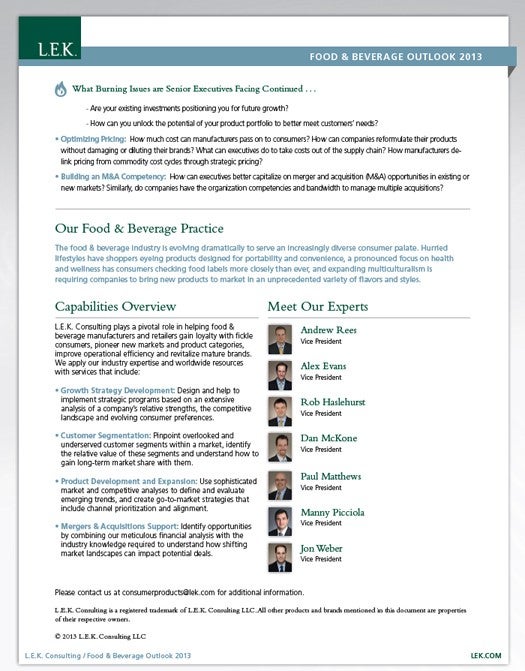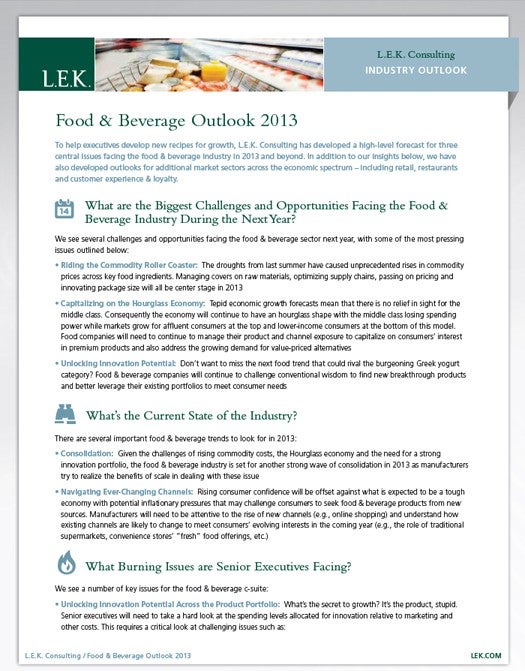
Summary
What are the Biggest Challenges and Opportunities Facing the Food & Beverage Industry During the Next Year?
We see several challenges and opportunities facing the food & beverage sector next year, with some of the most pressing issues outlined below:
- Riding the Commodity Roller Coaster: The droughts from last summer have caused unprecedented rises in commodity prices across key food ingredients. Managing covers on raw materials, optimizing supply chains, passing on pricing and innovating package size will all be center stage in 2013.
- Capitalizing on the Hourglass Economy: Tepid economic growth forecasts mean that there is no relief in sight for the middle class. Consequently the economy will continue to have an hourglass shape with the middle class losing spending power while markets grow for affluent consumers at the top and lower-income consumers at the bottom of this model. Food companies will need to continue to manage their product and channel exposure to capitalize on consumers' interest in premium products and also address the growing demand for value-priced alternatives.
- Unlocking Innovation Potential: Don't want to miss the next food trend that could rival the burgeoning Greek yogurt category? Food & beverage companies will continue to challenge conventional wisdom to find new breakthrough products and better leverage their existing portfolios to meet consumer needs.
What's the Current State of the Industry?
- Consolidation: Given the challenges of rising commodity costs, the hourglass economy and the need for a strong innovation portfolio, the food & beverage industry is set for another strong wave of consolidation in 2013 as manufacturers try to realize the benefits of scale in dealing with these issues.
- Navigating Ever-Changing Channels: Rising consumer confidence will be offset against what is expected to be a tough economy with potential inflationary pressures that may challenge consumers to seek food & beverage products from new sources. Manufacturers will need to be attentive to the rise of new channels (e.g., online shopping) and understand how existing channels are likely to change to meet consumers' evolving interests in the coming year (e.g., the role of traditional supermarkets, convenience stores' "fresh" food offerings, etc.).
What Burning Issues are Senior Executives Facing?
We see a number of key issues for the food & beverage c-suite:
- Unlocking Innovation Potential Across the Product Portfolio:What's the secret to growth? It's the product, stupid. Senior executives will need to take a hard look at the spending levels allocated for innovation relative to marketing and other costs. This requires a critical look at challenging issues such as:
- Are your existing investments positioning you for future growth?
- How can you unlock the potential of your product portfolio to better meet customers’ needs?
- Optimizing Pricing: How much cost can manufacturers pass on to consumers? How can companies reformulate their products without damaging or diluting their brands? What can executives do to take costs out of the supply chain? How can manufacturers de-link pricing from commodity cost cycles through strategic pricing?
- Building an M&A Competency: How can executives better capitalize on merger and acquisition (M&A) opportunities in existing or new markets? Similarly, do companies have the organization competencies and bandwidth to manage multiple acquisitions?
Sample Visuals
02142018170237


